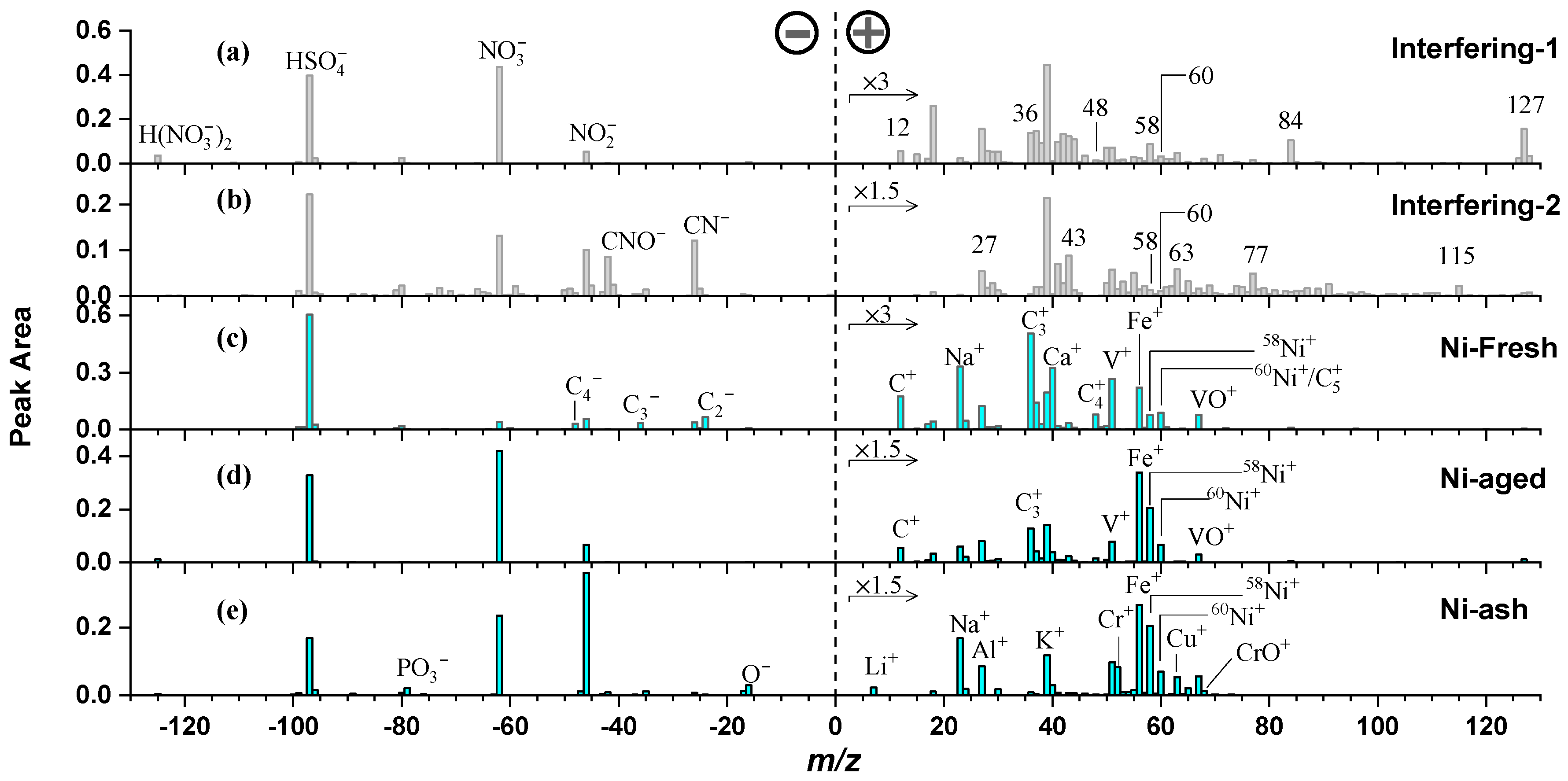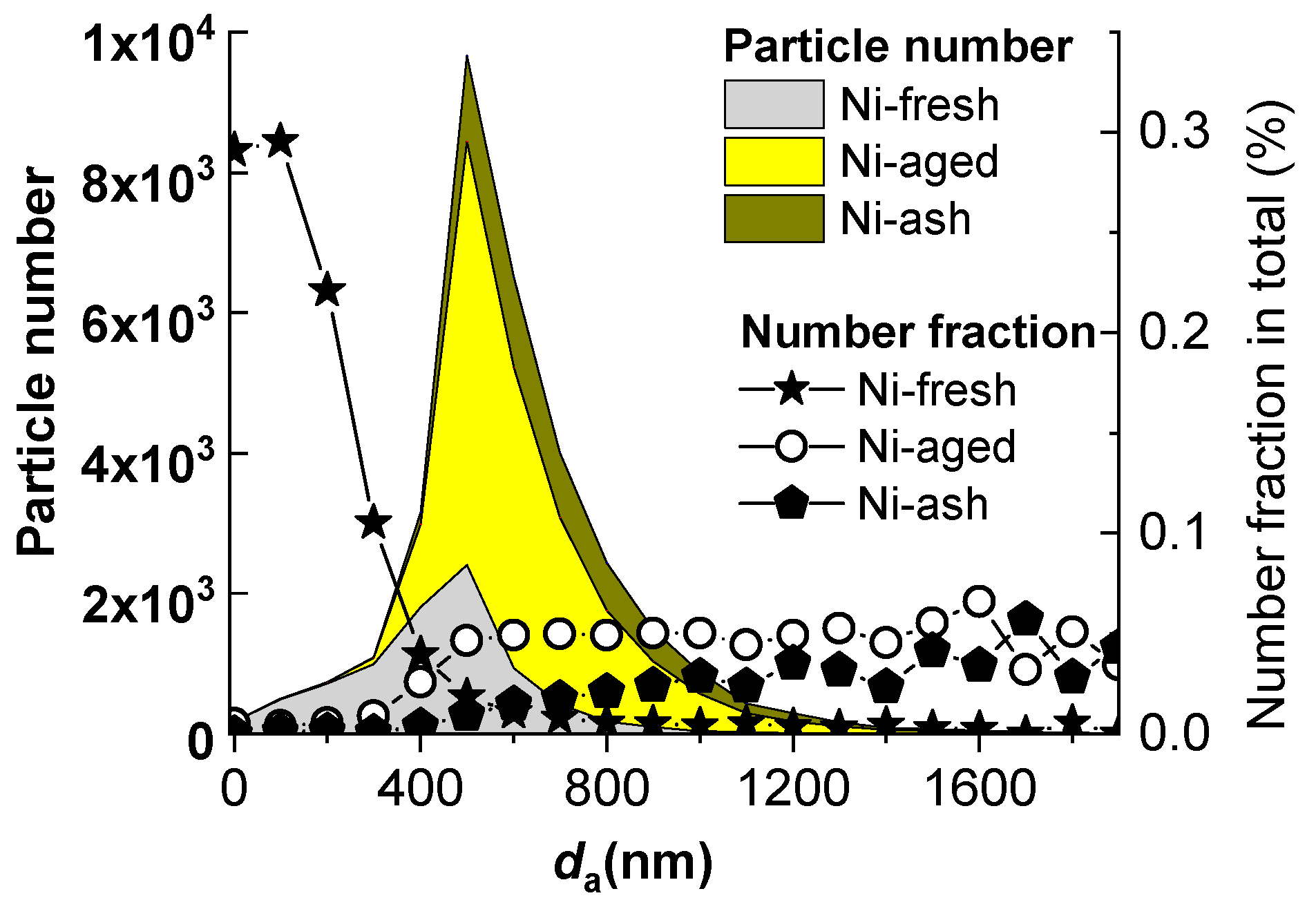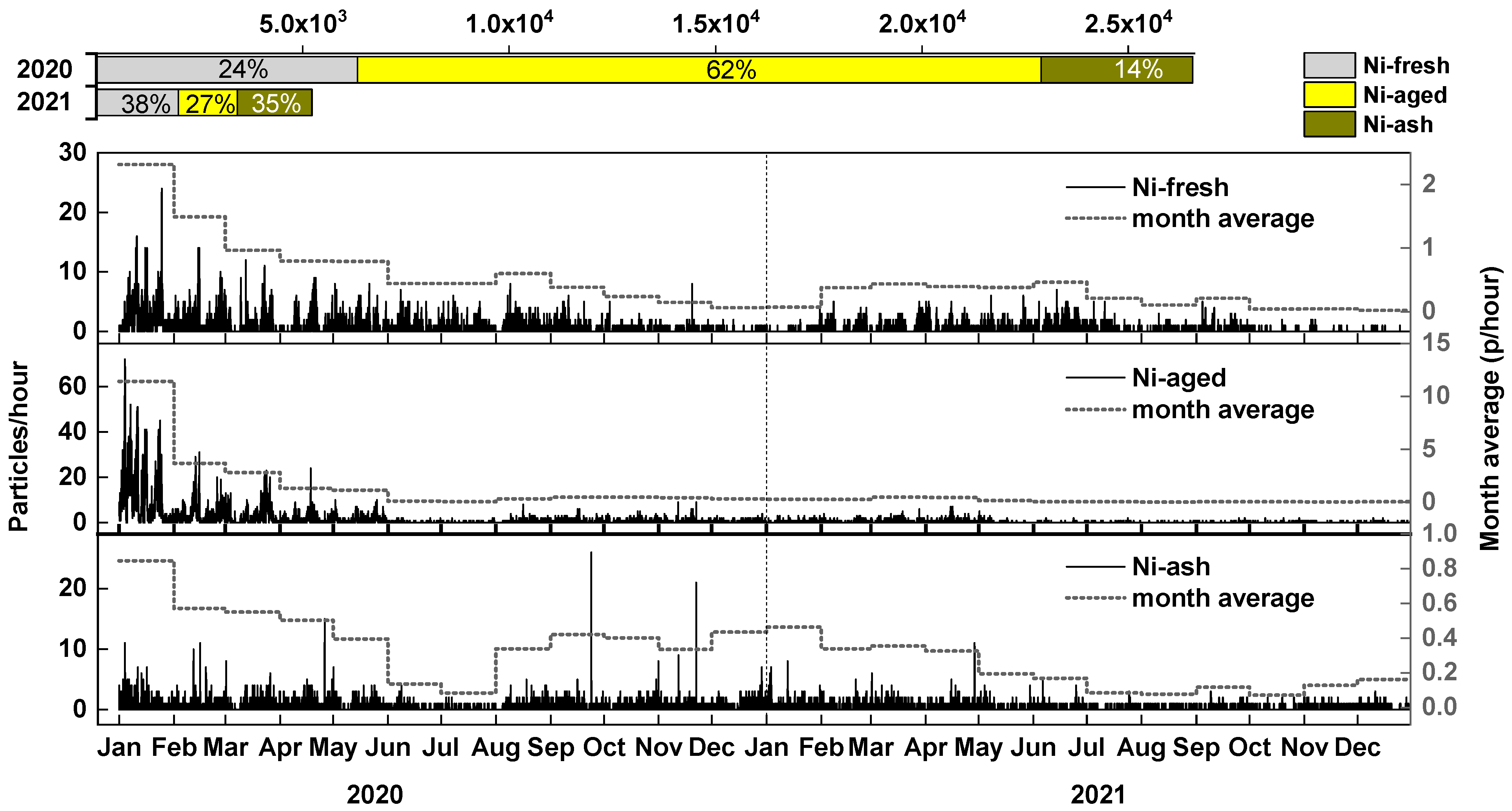Identification and Characterization of Atmospheric Nickel-Containing Particles in Guangzhou After the Implementation of the Clean Fuel Policy
Abstract
1. Introduction
2. Measurement Methods
2.1. The Measurement Site
2.2. Monitoring Instruments
2.3. Data Processing
3. Results and Discussion
3.1. Identification of Nickel-Containing Particles from Interfering Ions
3.2. Composition and Size Distribution of Nickel-Containing Particles
3.3. Source Analysis of Nickel-Containing Particles
3.4. Temporal Trends of Nickel-Containing Particles
3.5. Reduction in Vanadium-Associated Nickel Particles
4. Conclusions
- (1)
- Nickel-containing particles accounted for a relatively small proportion of total atmospheric particles, with an average number fraction of 0.08%, which is consistent with the mass fraction in previous studies;
- (2)
- Nickel-containing particles exhibited distinct chemical compositions and were classified into three types: freshly emitted HFO combustion particles, aged HFO combustion particles, and mineral dust/fly ash-type particles. Among these, freshly emitted HFO combustion particles were enriched in EC, sulfates, and characteristic metallic components, making them a major contributor to ultrafine nickel-containing particles near the port areas;
- (3)
- Aged HFO combustion particles and mineral dust/fly ash-type particles were predominantly distributed in the accumulation mode (>500 nm) and were enriched in secondary components, representing regional or background nickel-containing particles. Mineral dust/fly ash-type particles primarily originated from land-based emissions, whereas aged HFO combustion particles were mainly derived from regional ship emissions;
- (4)
- The implementation of the ship clean fuel policy greatly reduced the concentration of nickel-containing particles, leading to significant improvements in both local and regional air quality. Additionally, the policy led to changes in nickel particle composition and altered the relative contribution of different nickel emission sources. The success of the SECA policy has demonstrated that coordinated air quality management measures are effective in addressing regional air pollution, and this model can be applied not only to the shipping industry but also to other sectors.
Author Contributions
Funding
Institutional Review Board Statement
Informed Consent Statement
Data Availability Statement
Conflicts of Interest
References
- Dall’Osto, M.; Booth, M.J.; Smith, W.; Fisher, R.; Harrison, R.M. A study of the size distributions and the chemical characterization of airborne particles in the vicinity of a large integrated steelworks. Aerosol Sci. Technol. 2008, 42, 981–991. [Google Scholar] [CrossRef]
- Huang, W.; Zhang, Z.; Huang, J.; Tao, J.; Zhou, Z.; Yuan, Z.; Yang, Y.; Wang, B. High contribution of non-exhaust emission to health risk of PM2.5-bound toxic metals in an urban atmosphere in south China. Atmos. Environ. 2023, 306, 119824. [Google Scholar] [CrossRef]
- Yang, Q.; Liu, G.; Falandysz, J.; Yang, L.; Zhao, C.; Chen, C.; Sun, Y.; Zheng, M.; Jiang, G. Atmospheric emissions of particulate matter-bound heavy metals from industrial sources. Sci. Total Environ. 2024, 947, 174467. [Google Scholar] [CrossRef]
- Liu, Z.; Zhang, H.; Zhang, Y.; Liu, X.; Ma, Z.; Xue, L.; Peng, X.; Zhao, J.; Gong, W.; Peng, Q.; et al. Characterization and sources of trace elements in PM1 during autumn and winter in Qingdao, Northern China. Sci. Total Environ. 2022, 811, 151319. [Google Scholar] [CrossRef]
- Wang, X.; He, S.; Chen, S.; Zhang, Y.; Wang, A.; Luo, J.; Ye, X.; Mo, Z.; Wu, L.; Xu, P.; et al. Spatiotemporal Characteristics and Health Risk Assessment of Heavy Metals in PM2.5 in Zhejiang Province. Int. J. Environ. Res. Public Health 2018, 15, 583. [Google Scholar] [CrossRef] [PubMed]
- Fan, M.-Y.; Zhang, Y.-L.; Lin, Y.-C.; Cao, F.; Sun, Y.; Qiu, Y.; Xing, G.; Dao, X.; Fu, P. Specific sources of health risks induced by metallic elements in PM2.5 during the wintertime in Beijing, China. Atmos. Environ. 2021, 246, 118112. [Google Scholar] [CrossRef]
- Zhou, X.; Xie, M.; Zhao, M.; Wang, Y.; Luo, J.; Lu, S.; Li, J.; Liu, Q. Pollution characteristics and human health risks of PM2.5-bound heavy metals: A 3-year observation in Suzhou, China. Environ. Geochem. Health 2023, 45, 5145–5162. [Google Scholar] [CrossRef]
- Chen, L.C.; Lippmann, M. Effects of Metals within Ambient Air Particulate Matter (PM) on Human Health. Inhal. Toxicol. 2009, 21, 1–31. [Google Scholar] [CrossRef]
- Tian, L.; Ho, K.-f.; Louie, P.K.K.; Qiu, H.; Pun, V.C.; Kan, H.; Yu, I.T.S.; Wong, T.W. Shipping emissions associated with increased cardiovascular hospitalizations. Atmos. Environ. 2013, 74, 320–325. [Google Scholar] [CrossRef]
- Lippmann, M.; Ito, K.; Hwang, J.-S.; Maciejczyk, P.; Chen, L.-C. Cardiovascular Effects of Nickel in Ambient Air. Environ. Health Perspect. 2006, 114, 1662–1669. [Google Scholar] [CrossRef]
- Begum, W.; Rai, S.; Banerjee, S.; Bhattacharjee, S.; Mondal, M.H.; Bhattarai, A.; Saha, B. A comprehensive review on the sources, essentiality and toxicological profile of nickel. RSC Adv. 2022, 12, 9139–9153. [Google Scholar] [CrossRef] [PubMed]
- Zhao, J.S.; Shi, X.L.; Castranova, V.; Ding, M. Occupational Toxicology of Nickel and Nickel Compounds. J. Environ. Pathol. Toxicol. Oncol. 2009, 28, 177–208. [Google Scholar] [CrossRef] [PubMed]
- Schaumlöffel, D. Nickel species: Analysis and toxic effects. J. Trace Elem. Med. Biol. 2012, 26, 1–6. [Google Scholar] [CrossRef]
- Buxton, S.; Garman, E.; Heim, K.E.; Lyons-Darden, T.; Schlekat, C.E.; Taylor, M.D.; Oller, A.R. Concise Review of Nickel Human Health Toxicology and Ecotoxicology. Inorganics 2019, 7, 89. [Google Scholar] [CrossRef]
- Wang, Y.-F.; Shyu, H.-W.; Chang, Y.-C.; Tseng, W.-C.; Huang, Y.-L.; Lin, K.-H.; Chou, M.-C.; Liu, H.-L.; Chen, C.-Y. Nickel (II)-induced cytotoxicity and apoptosis in human proximal tubule cells through a ROS- and mitochondria-mediated pathway. Toxicol. Appl. Pharmacol. 2012, 259, 177–186. [Google Scholar] [CrossRef]
- Wataha, J.C.; O’Dell, N.L.; Singh, B.B.; Ghazi, M.; Whitford, G.M.; Lockwood, P.E. Relating nickel-induced tissue inflammation to nickel release in vivo. J. Biomed. Mater. Res. 2001, 58, 537–544. [Google Scholar] [CrossRef]
- Healy, R.M.; O’Connor, I.P.; Hellebust, S.; Allanic, A.; Sodeau, J.R.; Wenger, J.C. Characterisation of single particles from in-port ship emissions. Atmos. Environ. 2009, 43, 6408–6414. [Google Scholar] [CrossRef]
- de Foy, B.; Smyth, A.M.; Thompson, S.L.; Gross, D.S.; Olson, M.R.; Sager, N.; Schauer, J.J. Sources of nickel, vanadium and black carbon in aerosols in Milwaukee. Atmos. Environ. 2012, 59, 294–301. [Google Scholar] [CrossRef]
- Wang, X.; Shen, Y.; Lin, Y.; Pan, J.; Zhang, Y.; Louie, P.K.K.; Li, M.; Fu, Q. Atmospheric pollution from ships and its impact on local air quality at a port site in Shanghai. Atmos. Chem. Phys. 2019, 19, 6315–6330. [Google Scholar] [CrossRef]
- Healy, R.M.; Hellebust, S.; Kourtchev, I.; Allanic, A.; O’Connor, I.P.; Bell, J.M.; Healy, D.A.; Sodeau, J.R.; Wenger, J.C. Source apportionment of PM2.5 in Cork Harbour, Ireland using a combination of single particle mass spectrometry and quantitative semi-continuous measurements. Atmos. Chem. Phys. 2010, 10, 9593–9613. [Google Scholar] [CrossRef]
- Yu, G.; Zhang, Y.; Yang, F.; He, B.; Zhang, C.; Zou, Z.; Yang, X.; Li, N.; Chen, J. Dynamic Ni/V Ratio in the Ship-Emitted Particles Driven by Multiphase Fuel Oil Regulations in Coastal China. Environ. Sci. Technol. 2021, 55, 15031–15039. [Google Scholar] [CrossRef] [PubMed]
- Zhai, J.; Yu, G.; Zhang, J.; Shi, S.; Yuan, Y.; Jiang, S.; Xing, C.; Cai, B.; Zeng, Y.; Wang, Y.; et al. Impact of Ship Emissions on Air Quality in the Greater Bay Area in China under the Latest Global Marine Fuel Regulation. Environ. Sci. Technol. 2023, 57, 12341–12350. [Google Scholar] [CrossRef] [PubMed]
- Wu, Z.; Zhang, Y.; He, J.; Chen, H.; Huang, X.; Wang, Y.; Yu, X.; Yang, W.; Zhang, R.; Zhu, M.; et al. Dramatic increase in reactive volatile organic compound (VOC) emissions from ships at berth after implementing the fuel switch policy in the Pearl River Delta Emission Control Area. Atmos. Chem. Phys. 2020, 20, 1887–1900. [Google Scholar] [CrossRef]
- Li, L.; Huang, Z.; Dong, J.; Li, M.; Gao, W.; Nian, H.; Fu, Z.; Zhang, G.; Bi, X.; Cheng, P.; et al. Real time bipolar time-of-flight mass spectrometer for analyzing single aerosol particles. Int. J. Mass Spectrom. 2011, 303, 118–124. [Google Scholar] [CrossRef]
- Angelino, S.; Suess, D.T.; Prather, K.A. Formation of aerosol particles from reactions of secondary and tertiary alkylamines: Characterization by aerosol time-of-flight mass spectrometry. Environ. Sci. Technol. 2001, 35, 3130–3138. [Google Scholar] [CrossRef]
- Silva, P.J.; Liu, D.Y.; Noble, C.A.; Prather, K.A. Size and chemical characterization of individual particles resulting from biomass burning of local Southern California species. Environ. Sci. Technol. 1999, 33, 3068–3076. [Google Scholar] [CrossRef]
- Silva, P.J.; Prather, K.A. Interpretation of mass spectra from organic compounds in aerosol time-of-flight mass spectrometry. Anal. Chem. 2000, 72, 3553–3562. [Google Scholar] [CrossRef]
- Ren, Y.; Luo, Q.; Zhuo, S.; Hu, Y.; Shen, G.; Cheng, H.; Tao, S. Bioaccessibility and public health risk of heavy Metal(loid)s in the airborne particulate matter of four cities in northern China. Chemosphere 2021, 277, 130312. [Google Scholar] [CrossRef]
- Elliott, T.; Steele, R.C.J. The Isotope Geochemistry of Ni. Rev. Mineral. Geochem. 2017, 82, 511–542. [Google Scholar] [CrossRef]
- Gramlich, J.; Machlan, L.; Barnes, I.; Paulsen, P. Absolute isotopic abundance ratios and atomic weight of a reference sample of nickel. J. Res. Natl. Inst. Stand. 1989, 94, 347. [Google Scholar] [CrossRef]
- Liu, Z.; Lu, X.; Feng, J.; Fan, Q.; Zhang, Y.; Yang, X. Influence of Ship Emissions on Urban Air Quality: A Comprehensive Study Using Highly Time-Resolved Online Measurements and Numerical Simulation in Shanghai. Environ. Sci. Technol. 2017, 51, 202–211. [Google Scholar] [CrossRef]
- Nazari, E.; Rashchi, F.; Saba, M.; Mirazimi, S.M.J. Simultaneous recovery of vanadium and nickel from power plant fly-ash: Optimization of parameters using response surface methodology. Waste Manag. 2014, 34, 2687–2696. [Google Scholar] [CrossRef]
- Zhang, J.; Huang, Y.; Zhou, N.; Huang, Z.; Shi, B.; Yuan, X.; Sheng, L.; Zhang, A.; You, Y.; Chen, D.; et al. Contribution of anthropogenic emission changes to the evolution of PM2.5 concentrations and composition in the Pearl River Delta during the period of 2006–2020. Atmos. Environ. 2024, 318, 120228. [Google Scholar] [CrossRef]
- Ji, Y.; Zhang, Y.; Liu, D.; Zhang, K.; Cai, P.; Zhu, B.; Zhang, B.; Xian, J.; Wang, H.; Ge, X. Using machine learning to quantify drivers of aerosol pollution trend in China from 2015 to 2022. Appl. Geochem. 2023, 151, 105614. [Google Scholar] [CrossRef]
- Tichavska, M.; Tovar, B.; Gritsenko, D.; Johansson, L.; Jalkanen, J.P. Air emissions from ships in port: Does regulation make a difference? Transp. Policy 2019, 75, 128–140. [Google Scholar] [CrossRef]
- Anastasopolos, A.T.; Hopke, P.K.; Sofowote, U.M.; Mooibroek, D.; Zhang, J.J.Y.; Rouleau, M.; Peng, H.; Sundar, N. Evaluating the effectiveness of low-sulphur marine fuel regulations at improving urban ambient PM2.5 air quality: Source apportionment of PM2.5 at Canadian Atlantic and Pacific coast cities with implementation of the North American Emissions Control Area. Sci. Total Environ. 2023, 904, 166965. [Google Scholar] [CrossRef] [PubMed]
- Moreira, C.A.B.; Polezer, G.; dos Santos Silva, J.C.; de Souza Zorzenão, P.C.; Godoi, A.F.L.; Huergo, L.F.; Yamamoto, C.I.; de Souza Tadano, Y.; Potgieter-Vermaak, S.; Reis, R.A.; et al. Impact assessment of IMO’s sulfur content limits: A case study at latin America’s largest grain port. Air Qual. Atmos. Health 2024, 17, 2337–2351. [Google Scholar] [CrossRef]
- Chen, Y.; Rich, D.Q.; Masiol, M.; Hopke, P.K. Changes in ambient air pollutants in New York State from 2005 to 2019: Effects of policy implementations and economic and technological changes. Atmos. Environ. 2023, 311, 119996. [Google Scholar] [CrossRef]
- Mueller, N.; Westerby, M.; Nieuwenhuijsen, M. Health impact assessments of shipping and port-sourced air pollution on a global scale: A scoping literature review. Environ. Res. 2023, 216, 114460. [Google Scholar] [CrossRef]








Disclaimer/Publisher’s Note: The statements, opinions and data contained in all publications are solely those of the individual author(s) and contributor(s) and not of MDPI and/or the editor(s). MDPI and/or the editor(s) disclaim responsibility for any injury to people or property resulting from any ideas, methods, instructions or products referred to in the content. |
© 2025 by the authors. Licensee MDPI, Basel, Switzerland. This article is an open access article distributed under the terms and conditions of the Creative Commons Attribution (CC BY) license (https://creativecommons.org/licenses/by/4.0/).
Share and Cite
Wang, Z.; Chen, X.; Wu, C.; Ju, H.; Fu, Z.; Xiong, X.; Qiu, T.; Lu, Y.; He, J.; Liu, Y.; et al. Identification and Characterization of Atmospheric Nickel-Containing Particles in Guangzhou After the Implementation of the Clean Fuel Policy. Toxics 2025, 13, 345. https://doi.org/10.3390/toxics13050345
Wang Z, Chen X, Wu C, Ju H, Fu Z, Xiong X, Qiu T, Lu Y, He J, Liu Y, et al. Identification and Characterization of Atmospheric Nickel-Containing Particles in Guangzhou After the Implementation of the Clean Fuel Policy. Toxics. 2025; 13(5):345. https://doi.org/10.3390/toxics13050345
Chicago/Turabian StyleWang, Zaihua, Xuanxiao Chen, Cheng Wu, Hong Ju, Zhong Fu, Xin Xiong, Ting Qiu, Yuchen Lu, Junjie He, Yaxi Liu, and et al. 2025. "Identification and Characterization of Atmospheric Nickel-Containing Particles in Guangzhou After the Implementation of the Clean Fuel Policy" Toxics 13, no. 5: 345. https://doi.org/10.3390/toxics13050345
APA StyleWang, Z., Chen, X., Wu, C., Ju, H., Fu, Z., Xiong, X., Qiu, T., Lu, Y., He, J., Liu, Y., Wu, H., Cheng, C., & Li, M. (2025). Identification and Characterization of Atmospheric Nickel-Containing Particles in Guangzhou After the Implementation of the Clean Fuel Policy. Toxics, 13(5), 345. https://doi.org/10.3390/toxics13050345






